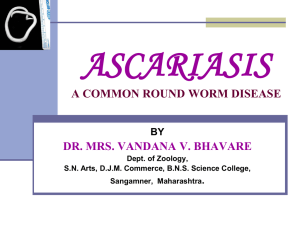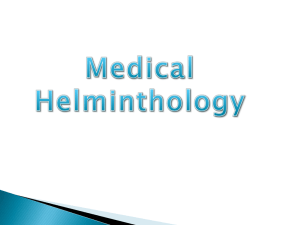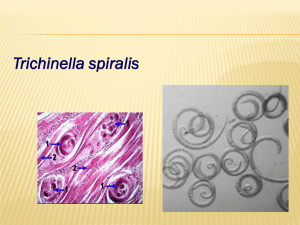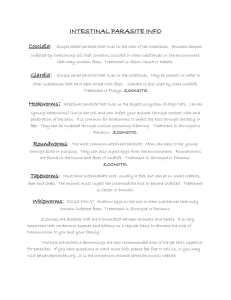Parasitology Lecture Notes(1)
advertisement
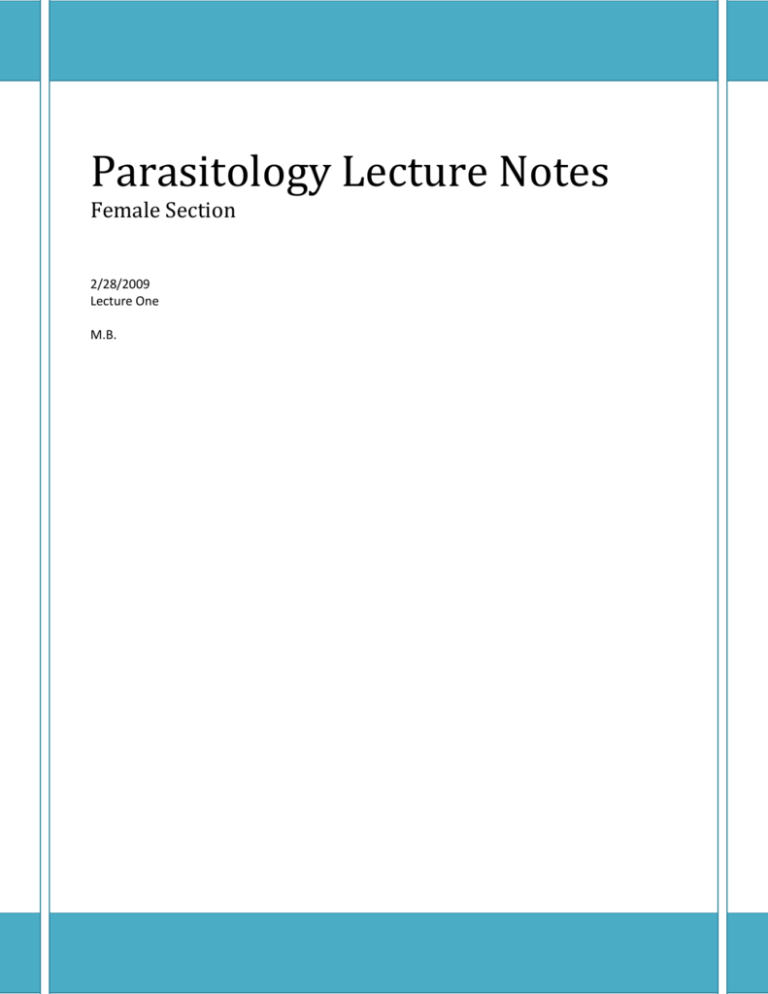
Parasitology Lecture Notes Female Section 2/28/2009 Lecture One M.B. Introduction Parasites are organisms adapts them selves to live in or on another organisms termed host. The relationship between the parasites and host occurs in 2 form: Commensalism: one of two organisms (commensal) benefits while the other host is unaffected (no benefit, no harm), commensal organism referred as non pathogenic. Parasitism : one of two organisms (parasite) benefits, gain shelter and nutrition on the expanse of the other (host). The host may suffer from wide range of functional and organic disturbances due to such association (pathogenic) Types of parasites: Ectoparasite : lives outside on the surface of the body (infestation). Endoparasite: lives inside the body of host Temporary or intermittent parasite: visits the host from time to time for food. Permanent parasite : remains on or in the body of the host for its entire life. Facultative parasite : organism that can exist in a free living state or as a parasite. Obligatory parasite : can not survive without a host i.e. completely adapted for parasitic existence. Opportunistic parasite : produces disease only in immunodeficient or immuno-suppressed patients (AIDS). In immunocompetent individuals the organisms may exist in latent form producing no symptoms. Coprozoic or spurious parasite foreign organisms which have been swallowed merely pass along alimentary canal of man (without establishment) to be recovered in faeces. (infection). Types of hosts: a-Definitive or final host : host with adult stage or sexually reproducing forms of the parasite. b-intermediate host : host with the larval stage or asexually reproducing forms of parasite. c-Reservoir host : animal that harbors the same species of parasite as man . such animal help to maintain the cycle of parasite in nature and act as a potential source for human infection with this parasite. d- Vector: an arthropod which carries the parasite from one host to another. zoonosis • Disease transmitted from animals to man are known as zoonotic diseases Mode of parasitic infections: Congenital from mother to foetus. Direct contact through the skin or sexually. Ingestion of contaminated food and water or undercooked meat in which the infective stage has developed. Penetration of the skin due to contact with infected soil or water stream. Inhalation of dust carrying the infective stage of parasite. Vectors: through the bite or faeces of infected vector or by swallowing the vector. Autoinfection: occurs when infective stages are carried from faeces to mouth of patient. Important terminology Prevalence = % of infection. Intensity = number of parasite in the host. Incidence = % of new infection Endemicity Endemic infection : when a steady rate of parasitic infection is prevalent all year around in a particular area causing a low rate of morbidity in population of this area. Hyper-endemic infection : when prevalence is high causing a high rate of morbidity. Epidemic infection : when there is a sharp increase in the incidence ,prevalence and morbidity rates . Epidemic outbreaks are usually due to introduction of a new parasite or vector in a non immune population. Sporadic infection : when a parasite appear occasionally in one or few members of a community. Source of parasitic infection Food -meat ( T.saginata, T. spiralis) -vegetables (Ascaris, E.histolytica) Water - protozoal cysts (E.histolytica, Cryptosporidium) - cercaria (Schistosoms) - cyclops (D.medinensis) Soil contaminated with faeces Ancylostoma ,Ascaris ,Strongyloides, Giardia . Association with domestic animals -dog :(hydatid disease ,toxocariasis ,leishmania) -cat : (Toxoplasma oocyst). Arthropods : Blood sucking (malaria, filarial, trypanosome, leishmania). Mechanical transmission (ova, protozoal cysts) Myiasis (invasion of tissue by larvae of flies) Blood transfusion : (erythrocytic stages of Plasmodium). Congenital transplantation : (toxoplasma, Plasmodium). Sexual intercourse : (Trichomonas vaginalis, Phthirus pubis). Inhalation of dust : (Enterobius ova). Parasites - Helminthes - Protozoa Protozoa Unicellular Single cell for all function Amoebae: move by pseudopodia. Flagellates: move by flagella. Ciliates : move by cilia Apicomplexa (sporozoa) Tissue parasites helminthes Multicellular Specialized cells Round worms (Nematodes) cylindrical, unsegmented Flat worms 1-Trematodes: leaf-like, unsegmented. 2-Cestodes: tape-like, segmented HELMINTHES Round worms (nematodes): Elongated, cylindrical, unsegmented. Flat worms: -Trematodes: leaf-like, unsegmented. - Cestodes : tape-like, segmented Round worms Common intestinal nematode infection: Enterobius (Oxyuris) vermicularis (Pinworm,seatworm,threadworm) Trichuris trichiura (whipworm) Ascaris lumbricoides (roundworm) Ancylostoma duodenale& Necator americanus (hookworm) Strongyloides stercoralis Nematodes General features: 1. Elongated worm, cylindrical, unsegmented and tapering at both ends. 2. Variable in size, measure less than 5mm~as long as 100cm. 3. Sex separate and male is smaller than female Location of Nematodes: Intestinal: Small intestine: Ascaris, Ancylostoma, Strongyloides Large intestine: Enterobius, Trichuris In Tissue W.Bancrofti : lymphatic system O.Volvulus & Loa loa , D.medinesis: subcutaneous tissue. Trichinella (larva): muscle, brain, lung. Toxocara canis : non human species larva carried in blood to liver, lung ,brain, eye…. Enterobius vermicularis ( Pinworm, seat worm,threadworm) Found all over the world. Adult found in cecum and appendix from which female migrate to rectum. It can seen by naked eye as white thread ±1cm. Male smaller than female with coiled tail ±0.5cm. Pathology Majority of infection is asymptomatic Main clinical presentation pruritus ani , perianal excoriation. Many cases presented by appendicitis. Ectopic enterobiasis occurs in female when invade valva and vagina result in valvovagintis Usually accompanied by insomnia, anorexia,loss of weight and concentration Treatment: Albandazole for whole family. Diagnosis Trichuris trichiurs (Whipworm) World wide ,common in poor sanitation. It coexists with Ascaris because of similar requirement. Adult live in large intestine especially caecum and appendix – in heavy infection the whole length of large intestine affected. Male and female worm have narrow anterior portion penetrate the intestinal mucosa. Embryonated egg Infective stage unembryonated egg Diagnostic stage Pathology light infection : asymptomatic heavy infection :abdominal pain ,bloody diarrhea. Rectal prolapse in children is a common complication. imp Diagnosis: egg in stool characterized by its barrel shape with mucoid plugs at each pole . Treatment :Albendazole. Ascaris lumbricoides (roundworm) The commonest humen helminthes infection. Found in jejunum and upper part of ileum. Female ±20 cm longer than male ±10 cm Feed on semidigested food. Infective stage Diagnostic stage Embryonated egg Unembryonated Pathology: 1-Adult worm Light infection asymptomatic. Heavy infection may cause intestinal obstruction Migrating adult to bile duct may cause jaundice 2-Larvae: Loefflers syndrome : Pneumonia,cough with bloody sputum, Eosinophilia, urticaria Loeffler`s syndrome: Larvae in lung pneumonia, cough ,bloody sputum Diagnosis : - eggs in stool. - larvae in sputum. Treatment: albendazol Hook warms Ancylostoma dudenale & Necator americanus The commonest cause of anemia. Found in small intestine mainly jejunum. Its buccal capsule (mouth) lined with hard hooks, triangular cutting plates and anticoagulant glands 1- Buccal cavity with intestinal mucosa 2-Buccal cavity with teeth & cutting plates anemia Pathology & Clinical Picture i-At the site of entry of larvae ( ground itch). ii-Migration phase of larvae: cough with bloody sputum pneumonia (loeffler`s syndrome) eosinophilia, urticaria. - Adult worm: low worm burden: no symptoms. Moderate to heavy burden: epigastric pain vomiting ,simulating duodenal ulcer hemorrhagic enteritis. Protein loss: hypoproteinaemia edema. Anemia: due to withdrawal of blood by parasites and hemorrhage from punctured sites lead to sever anemia = microcytic hypochromic . Diagnosis: -Eggs in stools.; -occult blood (+) Treatment: Albendazol Strongyloides stercoralis Widely distributed in tropical region worldwide . fetal opportunistic in immuno- compromised host. it is smallest pathogenic nematodes ±2.5mm. adult live in mucous membrane of duodenum, jejunum rarely m.m.of bronchus. Pathology and clinical picture: 1-Cutaneous little reaction on penetration. Sever dermatitis at perianal region in case of external autoinfection. 2- Migration :same as hook worms . 3- Intestinal: inflammation of upper intestinal mucosa, diarrhea, upper abdominal pain colicky in nature. Disseminated strongyloidiasis in patient with immuno-deficiency -uncontrolled diarrhea , granulomatus changes , necrosis, perforation, peritonitis, death. - Invation of liver, lung and brain Diagnosis Stool examination (rhabditiform larvae diagnostic stage) Duodenal aspirate& tissue biopsy for larvae Treatment: albandazole - Opportunistic parasite. in (immunocompromised) - Facultative parasite. (parasitic and free) - Autoinfection (perianal skin, intestine). - Can be diagnosed by duodenal aspirate. Tissues Nematodes Commen tissue nematodes • Toxocara canis (dog round worm) • larvae in organs (liver, brain, eye) causing visceral larva migrans.imp • Trichinella spiralis Adult in small intestine Larva in tissue (mainly in muscles) • Dracunculus medinensis (guinea worm) adult female in SC tissues. • Filarial worm (adult worm + microfilaria) Filarial worms Onchocerca volvulus Adults in SC swellings ,Microfilaria mainly in skin, in eye causing River blindness. Wucheraria bancrofti, Burgia malayi& B.timori :Lymphatic filariasis (adult in lymphatic ,and microfilaria in blood ) Loa loa adult in sc and subconjanctival tissues,causing calabar swelling microfilaria in blood Toxocara canis Similar to human ascaris but with alternative pathways. Larvae do not develop to adult in human but migrate continuously in viscera and encapsulate causing tissue damage. (parasitic granuloma) Many puppies are born infected with T. canis. T. canis and T. cati may cause visceral larvae migrans in children who eat soil contaminated with (embyronated) infected eggs. Pathology Eosinophalia, hepatomegaly, retinitis. Diagnosis : serology, biopsy. Treatment : albendazole Trichinella spiralis Pathology: Adults – mild gastroenteritis (nausea, dysentery, colic). Larvae -fever, pain in muscles( myositis), swelling, - nervous ,pulmonary and cardiac disorders. Diagnosis - by muscle biopsy (microscopic observation), - serology. Treatment: Albendazole or mebendazole+corticosteroids Management: Prevention – -cook meat thoroughly (pigs), -cook garbage fed to pigs, -salting will not kill juveniles, proper freezing will. Relieve symptoms with analgesics and corticosteroids (albadazole) Wucheraria bancrofti Wuchereria bancrofti, Brugia malayi Disease - filariasis, elephantiasis Worms restrict normal flow of lymph and result in swelling, fibrosis and eventually secondary infections in the affected tissues (usually legs and groin). Lymphatic filariasis Mainly caused by W.bancrofti, due to adult worms obstructing lymphatic. - Acute : lymphadedenitis, lymphatic varices. - Chronic : lymphedema, hydrocele, chyluria. Diagnosis: detection of m.f.in blood in early stage of disease -Blood film , -Knott`s method (concentration of 1ml of blood) best at 10 pm to 2 am (nocturnal periodicity). Treatment: diethylcabamazine (DEC) or ivermectin Onchocerca volvulus Pathology: Nodules consisting of collagen fibers surrounding one to several adult worms . An allergic dermatitis from toxins released after m.f. die in skin. Blindness following invasion of cornea by m.f. It takes many year to develop, victim are over 40 year. inflammation with the loss of tissue elasticity can lead to protruding lymph glands folded in pockets of skin. This condition is especially prominent in the areas around the scrotum (often called the 'hanging groin' effect) and in severe cases is classified as minor elephantiasis Management: 1. surgery to remove the nodules. 2. Drug therapy kills adults and causes slow disappearance of m.f. 3. Control black flies.(Simulium). Diagnosis: by skin snips it is bloodless snips. Loa loa Common name - eye worm Disease - loiasis, loaiasis Intermediate host is deer fly (Chrysops). Diurnal periodicity. In Africa. Diagnosis Is by finding m.f.in blood during day time (diurnal periodicity). Treatment Surgical removal of swellings. Chemotherapy diethyl-carbamazine (DEC) or ivermectin Dracunculus medinensis Common name: Guinea worm, medina worm, serpent worm Adult females in subcutaneous tissues of the legs and arms. Ulcer forms over nematod ,uterus ruptures and discharge larvae into water. Larvae ingested by intermediate host (cyclop) Cyclop swallowed by man, migrate via lymph system ,develop to adult in subcutaneous tissues Pathology: None - until blister forms and toxic fluids result in ◦ a rash accompanied by severe itching ◦ nausea , vomiting ,diarrhea, dizziness. Secondary bacterial infections of opening are possible. Management: Filter or boil water, or treat with chlorine to kill intermediate host. Avoid bathing or wading in drinking water. Remove worms by extraction or with surgery. Drug therapy. Feature of human intestinal nematodes Adult live in intestinal tract. Female are oviparous i.e. lay eggs. Humans are host of major intestinal nematodes of medical importance. Most species are spread by fecal pollution of soil. soil transmitted disease larvae (free or in egg) develops to its infective stage in soil. Infection by - swallowing of infective eggs . (A.lumbricoides,T.trichiura, E.vermicularis) - or penetration of skin by infective larvae. (Hook worms, S.stercoralis) Larvae of A.lumbricoides S.stercoralis and Hookworms (under go heart to lungmigration). flariform larvae is infective stage of S.stercoralis and Hookworm by penetration of skin. Rabditiform larvae is used to describe larvae that hatch from egg in intestine (S.stercoralis ) or in soil in (hook worms) . Laboratory confirmation: A.lumbricoid, T.trichiura, and Hookwormsis by finding eggs in feces and with S.stercoralis by finding larvae in stool. E.vermicularis by scotch tape from skin around anus. Some time worms of A.lumbricodis and E.vermicularis can be recovered in stool.
